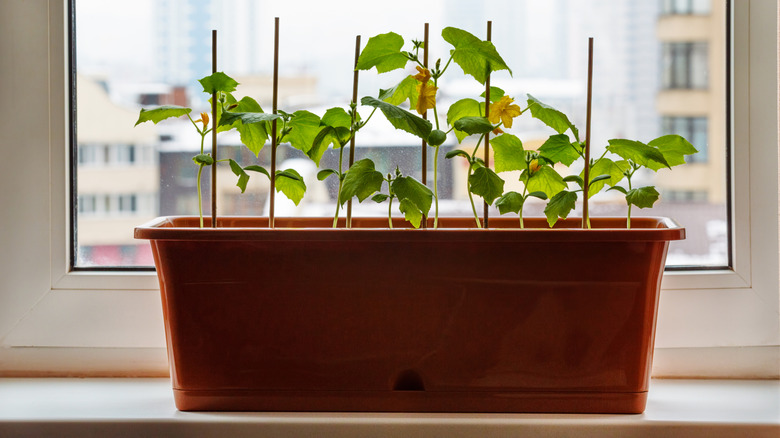Here's How To Grow Cucumbers Indoors – Without Them Dying
Cucumbers are underrated icons of the kitchen. Whether you're slicing them for a Greek quinoa salad, whipping up some easy tzatziki sauce, or crafting Swedish-style pickled cucumbers to pair with your meatballs, it's always good to have a few available. And what if we told you there was a way to have them on hand all the time? To find out how, Food Republic spoke with Angelika Zaber, a lawn care specialist and gardening expert working for Online Turf.
"If you want to grow cucumbers indoors, start by purchasing the right pots," Zaber told us. To make life easier, we came up with a bucket guide for growing cucumbers. "For best results, make sure that they have the capacity of at least 5 gallons." Cucumber plants have large root systems and grow quickly, even indoors. This means that they need a pot that can hold enough soil to provide essential nutrients and retain adequate moisture for healthy growth. "Each pot should also have drainage holes, as cucumbers like well-draining soil that's not waterlogged," she added. "On a similar note, choose a high-quality potting mix that is well-draining and nutrient-rich."
There are many cucumber varieties, but not all are suitable for indoor growing, especially those that produce long vines, like the Boston pickling cucumber, or those that need pollinators such as bees to fruit. Instead, Zaber recommends compact, self-pollinating varieties like Japanese or patio cucumbers, which thrive in indoor conditions.
Cucumbers need careful watering, feeding, and warm temps
With plants, the general rule of thumb is simple: They can't grow without sunlight. Light is essential for photosynthesis, the process that allows plants to feed themselves and thrive. If your home doesn't get much direct light, consider investing in a UV light that mimics the sun's rays.
Angelika Zaber advised, "Fill the containers to an inch or two below the rims and sow [two to four] seeds about an inch deep in the center of the pot." She continued, "Provide [your cucumbers] with a temperature between 70... and 85 degrees Fahrenheit during the day and around 60 degrees... at night, [and] regularly perform a finger test so you know when to water them." To help you stay consistent with your watering, you can use one of the many plant care apps that let you set reminders.
Watering also changes seasonally. During winter, water less frequently; in summer, water more. "You should also feed your indoor cucumbers every two weeks with a general liquid fertilizer, switching to high-potash liquid fertilizer to encourage flowering and fruiting," Zaber added.
Plants can be stubborn, and even the most dedicated green thumb knows the struggle of getting watering just right. Overwatering can be just as harmful — if not worse — than underwatering. "Cucumbers need a soil that's consistently moist, but not waterlogged, so too much water suffocates the roots, while not enough water causes them to dry out quickly," Zaber said. In this case, less is more. After all, you can always add more water if needed, but you can't take it away once it's there.


